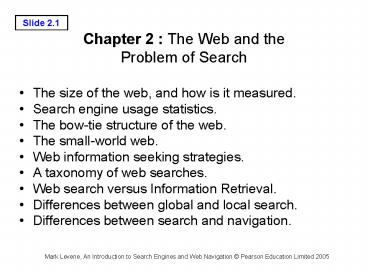Chapter 2 : The Web and the Problem of Search
Title:
Chapter 2 : The Web and the Problem of Search
Description:
OVR is the number of pages returned by both search engines for typical queries. ... Users typical habits are different (short queries, inspect only top-10 pages) ... –
Number of Views:58
Avg rating:3.0/5.0
Title: Chapter 2 : The Web and the Problem of Search
1
Chapter 2 The Web and theProblem of Search
- The size of the web, and how is it measured.
- Search engine usage statistics.
- The bow-tie structure of the web.
- The small-world web.
- Web information seeking strategies.
- A taxonomy of web searches.
- Web search versus Information Retrieval.
- Differences between global and local search.
- Differences between search and navigation.
2
Web size statistics
- Number of accessible web pages latest estimate,
May 2005, 11.5 billion. - The deep (or hidden or invisible) web contains
400-550 times more information. - Coverage (i.e. the proportion of the web indexed)
is crucial for search engines.
3
Measuring the size of the web
- Capture-recapture method
- SE1 is the number of pages indexed first search
engine. - QSE2 is the number of pages returned by second
search engine for typical queries. - OVR is the number of pages returned by both
search engines for typical queries. - Estimate (SE1 x QSE2)/OVR
- Estimate of 64.81 million web sites as of June
2005.
4
Web usage statistics
- Over 10 of the worlds population were online as
of late 2004. - Number of broadband users is growing (over 50 of
connected Americans use broadband). - Search engine usage as of June 2004
- Google (41.6), Yahoo! (31.5), MSN (27.4), AOL
(13.6), Ask Jeeves (7) - 200 million hits per day to Google (mid 2004).
5
Tabular Data versus Web Data
- Figure 2.1 A database table versus a web site
6
Structure of the web
- Figure 2.2 Map of the Internet (1998)
7
Structure of the web
- Figure 2.3 Web pages related to dcs.bbk.ac.uk
- (see www.touchgraph.com)
8
Structure of the web
- Figure 2.4 Bow-tie shape of the web
9
The small-world web
- Over 75 of the time there is no directed path
from one random web page to another. - When a directed path exists its average length is
16 clicks. - When an undirected path exists its average length
is 7 clicks. - Short average path between pairs of nodes is
characteristic of a small-world network.
10
Web information seeking strategies
- Direct navigation
- Enter the URL directly into the browser.
- Navigation within a directory
- Use a web portal as an entry point to the web.
- Information seeking on the web is problematic and
more users are turning to search engines.
11
Navigation using a search engine
- Figure 2.5 Information seeking
12
A taxonomy of web searches
- Informational acquire some information about a
topic from web pages. - Navigational find a site to start navigation
from. - Transactional perform some activity mediated by
a web site.
13
Web search versus Information Retrieval
- The scale of web search is way beyond traditional
information retrieval. - The web is very dynamic.
- The web contains an enormous amount of
duplication. - The quality of web pages is not uniform.
- The range of topics on the web is open.
- The web is globally distributed.
- Users typical habits are different (short
queries, inspect only top-10 pages). - The web is hypertextual.
14
Information retrieval evaluation
- Figure 2.6 Recall versus precision
15
Differences between global and local search
- Local search engines on web sites have a bad
reputation. - Users often use a web search engine such as
Google or Yahoo! to find information on web
sites, rather than the local web site search
engine. - Many companies do not invest in local search.
- Content management is a problem.
- Language may be a problem.
- Information needs on web sites may be different.
16
Differences between search and navigation
- Search employing a search engine to find
information. - Navigation (or surfing) employing a
link-following strategy to find information. - The web encourages a combination of search,
navigation and browsing.































